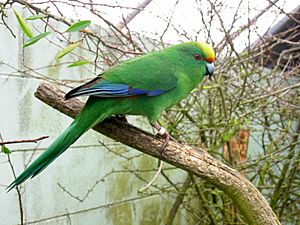Orange-fronted parakeet facts for kids
The term Orange-fronted parakeet can be a bit confusing because it refers to two different types of birds! Both are colorful and interesting, but they live in very different parts of the world. Let's learn about each one.
Contents
The Orange-fronted Conure (Central America)
The Orange-fronted Conure (scientific name: Eupsittula canicularis) is also known as the Half-moon Conure. This lively bird makes its home in the warm, sunny regions of Central America. You can find them in countries like Mexico, Guatemala, El Salvador, Honduras, Nicaragua, and Costa Rica.
What Does It Look Like?
These conures are medium-sized parrots, usually about 23 to 25 centimeters (9 to 10 inches) long. They are mostly green, but they have a bright orange patch on their forehead, right above their beak. This orange patch is where they get their name! They also have a bit of blue on their crown and a pale yellow ring around their eyes. Their beaks are horn-colored, and their feet are grey.
Where Do They Live and What Do They Eat?
Orange-fronted Conures prefer dry, open woodlands, thorny scrub, and even areas near farms. They are often seen in groups, flying quickly through the trees. Their diet mainly consists of seeds, fruits, and flowers. They love to eat the seeds from acacia trees and the fruit from fig trees. Sometimes, they might visit orchards, which can make farmers a little unhappy!
Their Social Life
These birds are very social and often live in large flocks. You'll usually hear them before you see them because they are quite noisy! They make loud, chattering calls, especially when they are flying or feeding. They nest in tree cavities, often old woodpecker holes. Both parents work together to raise their chicks.
Malherbe's Parakeet (New Zealand)

The Malherbe's Parakeet (scientific name: Cyanoramphus malherbi) is also known as the Orange-fronted Parakeet or kākāriki karaka in the Māori language. This special bird lives far away from Central America, in the forests of New Zealand. It is one of the rarest parrots in the world.
What Makes It Unique?
Malherbe's Parakeet is a small, bright green parrot, usually about 20 centimeters (8 inches) long. Like its Central American namesake, it has a distinctive orange band across its forehead. It also has a blue-green stripe behind its eyes. Its feathers are a beautiful mix of green, blue, and orange, helping it blend into the lush New Zealand forests.
Where Do They Live?
Unlike the widespread conure, Malherbe's Parakeet is found only in a few specific valleys on the South Island of New Zealand. They prefer native beech forests, especially those near rivers. They spend a lot of their time foraging on the ground among the leaf litter or in the lower branches of trees.
Diet and Behavior
These parakeets mainly eat seeds, fruits, flowers, and small insects. They are quite shy and can be hard to spot in the dense forest. They are known to be active during the day, searching for food.
Why Are They So Rare?
Malherbe's Parakeet is critically endangered, which means it's at a very high risk of disappearing forever. Their numbers have dropped because of habitat loss (their forest homes being cut down) and predators like stoats, cats, and rats, which were introduced to New Zealand by humans. Many people in New Zealand are working hard to protect these beautiful birds and help their populations grow again. This includes controlling predators and protecting their forest homes.

